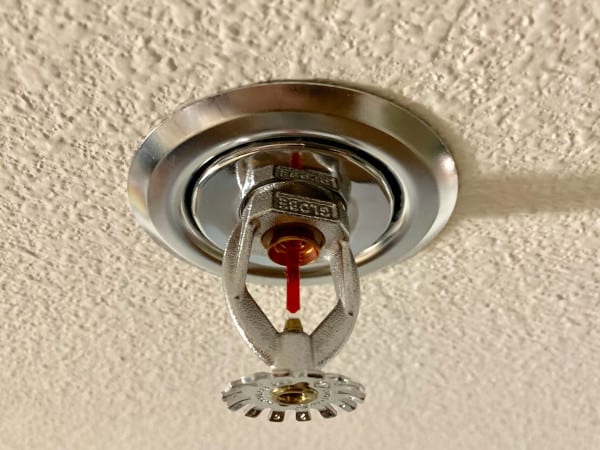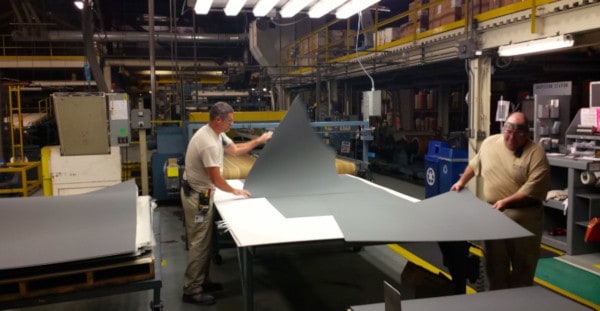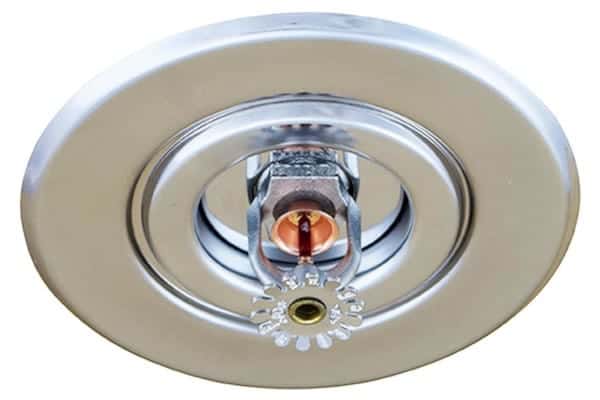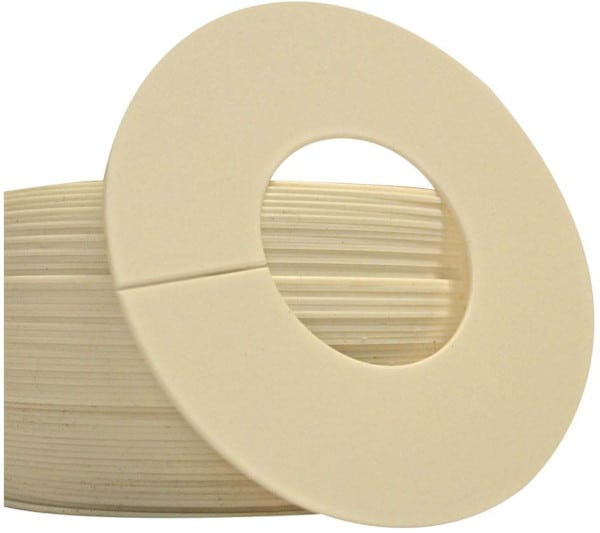Holes behind fire sprinklers, whether accidental or intentional, need to be covered—but escutcheons aren’t always up to the task
Kydex® ceiling rings, a type of fire sprinkler trim ring or “oops ring,” can make sprinkler fitters’ lives a great deal easier. Installing a sprinkler against a wall or ceiling will typically require drilling a small hole. While some standard sprinkler components usually cover those holes — namely, escutcheons — some gaps are simply too large to cover easily.
Kydex rings serve as an alternative to patching drywall or, where large holes must remain in place, purchasing specialty components. In this article, we explain how these fire sprinkler trim rings work, where fire or building codes may require them, and how to add one to a new or existing system.
Feel free to browse our selection of Kydex rings and metal fire sprinkler trim rings now. If you’d like, you can also take a look at our wide variety of escutcheons and tools for portable, precision hole-cutting.
Kydex rings, installed in ceilings and walls, safely prevent heat from bypassing fire sprinklers
Covering oversized holes helps to ensure proper sprinkler activation
Installers have a variety of specialty tools at their disposal for cutting holes precisely. But cutting holes for fire sprinkler heads is harder than it might seem at first. And some holes in walls and ceilings may have too large or uneven a shape to cover by conventional means. Not all oversized gaps result from contractor error, though. Buildings in earthquake-prone regions must comply with a host of seismic rules, including fire code provisions that require extra clearance around fire sprinkler heads.
Regardless of the reason, holes around fire sprinkler head require coverage. Sprinklers that pass through walls or ceilings—namely, those of the sidewall (wall-mounted) and pendent (ceiling-mounted) varieties—generally accomplish this with escutcheons. These “trim plates” or “beauty rings” serve two purposes:
- Enhancing the appearance of sprinkler heads. Without these plates, unsightly holes through drywall and other materials remain exposed.
- Ensuring that the sprinkler activates on time. Holes allow heat to bypass sprinkler heads. Consequently, the area around the sprinkler head remains cooler longer. As a result, the heat-sensitive parts of a fire sprinkler won’t activate as soon as they should, and the fire spreads.

Kydex rings install on walls or ceilings behind escutcheons, blocking the passage of heat with fire-rated material
To cover an oversized hole, contractors can either install an extra-large escutcheon or combine a standard-sized escutcheon with a large, fire-resistant ring. Kydex ceiling rings fall into the second category, providing an affordable, easy-to-install alternative to oversized escutcheons. These fire sprinkler trim rings slip behind existing escutcheons, covering holes as large as 4″.
They also make retrofits significantly easier. Replacing a standard-sized escutcheon with an extra-large model generally involves detaching and reinstalling the sprinkler head. That means that contractors would need to shut down the fire sprinkler system (at least partially). Kydex sprinkler rings, on the other hand, have a slit that allows installers to easily seat them behind an existing escutcheon.
They’re also helpful when replacing or removing tiles seated behind pendent fire sprinklers. While installing a brand-new tile with a perfectly cut hole would require removing an existing sprinkler head, Kydex rings allow extra-large holes to be drilled for convenience’s sake. Installers can slide the new tile with the extra-large hole over the existing sprinkler and escutcheon, and use the Kydex ceiling ring to cover the gap.
But what, exactly, is Kydex? Manufactured by Sekisui Polymer Innovations, Kydex is the brand-name for a line of high-strength materials that can be heated and cooled repeatedly with little or no change to their shape. These acrylic-polyvinyl chloride materials are used to make knife sheaths, gun holsters, airplane cabins, and a host of other materials.
Critically, Kydex ceiling rings are fire-rated. Made from a sheet of fire-rated Kydex-T, these fire sprinkler trim rings meet the standards of UL 94, which evaluates the burning rate, flame spread, and other characteristics of plastic materials.

Kydex fire sprinkler trim rings can prove useful when seismic requirements call for clearance around sprinkler heads
Not all Kydex trim rings cover unintentionally large holes. Contractors that install fire sprinkler systems in accordance with NFPA 13: Standard for the Installation of Sprinkler Systems may be required to leave two to four inches of clearance around pipes passing through walls — as happens with sprinklers using extended escutcheons — or three inches around heads. The 2019 edition of NFPA 13 provides these guidelines:
- If a building’s fire sprinkler system requires protection against seismic damage, contractors may follow the guidelines provided in NFPA 13 (chapter 18) or provide alternative protection as recommended in a seismic analysis (sections 18.1.1-18.1.2).
- Seismic requirements do not eliminate contractors’ responsibility to stop the movement of smoke, fire, or water around fire sprinkler heads and piping (A.18.4).
- Pipes need clearance under this section when they pass through “walls, floors, platforms, and foundations” (18.4.1). For nominal pipe sizes from 1″ to 3 1/2″, holes should be 2″ larger (nominal) than the pipe (18.4.2). For sizes 4″ and greater, holes should be 4″ larger (18.4.3).
- 3″ of clearance is required between a fire sprinkler and structural elements “not used collectively or independently to support the sprinklers,” including beams, girders, and trusses, but not frangible ceilings (18.4.11).
- This 3″ of clearance isn’t required for sprinklers attached to piping with flexible hose (18.4.11.1).
Other standards prescribe different levels of clearance. The International Building Code (IBC), used in many jurisdictions throughout the United States, requires as much as 1″ of space around fire sprinklers in buildings subjected to moderate to severe shaking. These clearances vary with the level of seismic activity expected. The three most earthquake-prone types of structures require 1″ of clearance in all directions, while select others require only 1/4″ of clearance.

Kydex rings are easy to purchase and require few steps for installation
During a new sprinkler system installation, adding a Kydex ceiling ring is easy:
- Attach the escutcheon to the sprinkler in accordance with the manufacturer’s instructions
- Slip the Kydex sprinkler ring over the escutcheon
- Thread the sprinkler assembly into the piping until snug
With existing fire sprinklers, adding a Kydex ring involves almost as little effort:
- Twist the ring to expose the pre-cut slit leading from the outer edge to the center hole
- Split the ring along the slit, using scissors as needed
- Push gently against the ceiling tile and slide the inside edge of the ring underneath the escutcheon’s edge
As the foregoing suggests, Kydex rings serve as one of the easiest and least expensive ways to cover oversized holes. If you’d like to cover oversized holes — or drill new holes precisely — look at our selection of fire equipment, including:
- Kydex rings and metal fire sprinkler trim rings
- Fire sprinkler escutcheons
- Precision hole-cutting pilot clamps.
Browse our Kydex rings for walls and ceilings.
Questions? Call us at +1 (888) 361-6662 or email support@qrfs.com.
This blog was originally posted at blog.qrfs.com. If this article helped you, check us out at Facebook.com/QuickResponseFireSupply or on Twitter @QuickResponseFS.


